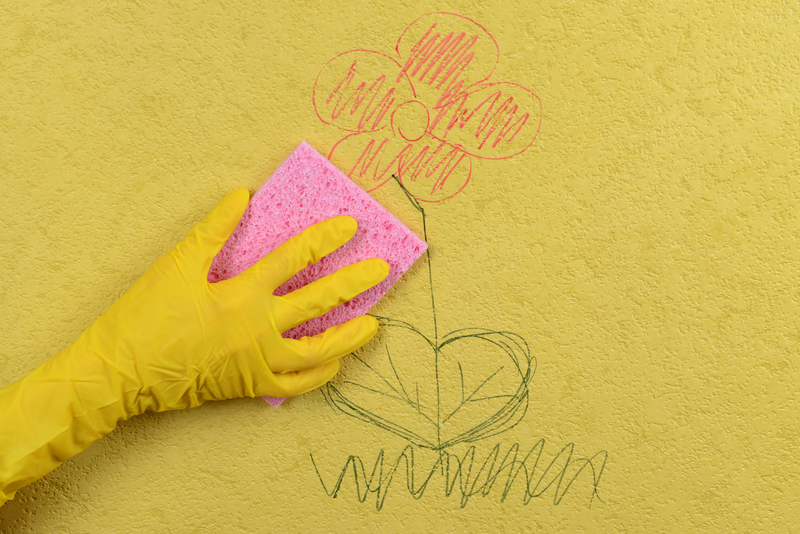Essential Steps for Removing Mould from Window Sills
Posted on 20/08/2025
Essential Steps for Removing Mould from Window Sills
Are you noticing unsightly black spots or a musty odor around your window sills? If so, you're not alone. Mould is a common issue for many homeowners, especially in rooms with high humidity or poor ventilation. Not only can it be an eyesore, but mould can also impact your health and the structural integrity of your home if left untreated.

Why Does Mould Grow on Window Sills?
Mould, which comes in many varieties like the notorious black mould (Stachybotrys chartarum), thrives on moisture, warmth, and organic matter. Window sills are particularly vulnerable because condensation from windows provides the perfect humid environment for mould spores to settle and spread. Factors such as inadequate insulation, frequent rain, and poor airflow contribute to window sill mould growth.
- High humidity: Encourages condensation around window frames.
- Poor ventilation: Traps moist air inside, facilitating mould development.
- Organic material: Paint, dust, and wood on sills serve as food sources for mould spores.
How Dangerous Is Mould on Window Sills?
Exposure to mould can be a health hazard. Individuals with allergies, asthma, or compromised immune systems are especially susceptible to reactions such as coughing, sneezing, watery eyes, and even asthma attacks. Additionally, persistent mould can damage the wood, paint, and plaster around your windows, leading to expensive repairs.
- Health risks: Allergic reactions, respiratory problems
- Structural damage: Rots wood and bleaches paint
- Lower property value: Visible mould is a red flag for buyers/tenants
Indications of Mould on Window Sills
Recognizing mould early makes removal easier and prevents widespread contamination. Look for the following warning signs:
- Black, green, or white spots on sills or window frames
- Musty, earthy smells near windows
- Peeling paint or discoloration of sills and nearby surfaces
- Condensation gathered on windows, especially in the morning
Gathering Supplies for Mould Removal from Window Sills
To effectively remove mould from your window sills, assemble these essential tools and cleaning materials:
- Protective gear: Gloves, safety goggles, and a face mask to avoid mould exposure
- Brush or scrubbing pad
- Spray bottle filled with cleaning solution
- Old toothbrush for intricate areas
- Microfiber cloth or paper towels
- Baking soda, white vinegar, or mild detergent (for DIY solutions)
- Commercial mould remover (optional)
- Bucket of clean water
Step-by-Step Guide: How to Remove Mould from Window Sills
Follow these comprehensive steps to effectively eliminate mould from window sills and prevent its return.
1. Ensure Safety First
Mould releases spores into the air when disturbed. Always wear gloves, a protective mask, and goggles before you begin. Open the window to improve air circulation and, if possible, move any nearby furniture away from the area.
2. Prepare and Apply Your Cleaning Solution
Several cleaning options are available to remove mould from window sills:
-
White vinegar:
- Pour undiluted vinegar into a spray bottle and cover the affected area. The acetic acid in vinegar helps kill up to 82% of mould species.
-
Baking soda solution:
- Mix 1 teaspoon of baking soda with 2 cups of water. Spray or apply to the mould, then scrub with a brush.
-
Mild detergent and warm water:
- For painted wood or stubborn stains, mix a few drops of detergent with water.
-
Commercial mould and mildew removers:
- Follow product instructions closely; many contain bleach or hydrogen peroxide.
3. Scrub the Affected Area Carefully
Using your brush, sponge, or cloth, gently but firmly scrub the mould from the window sill. Start from the outer edges and work toward the centre to prevent spreading spores to uncontaminated areas.
- Use an old toothbrush for hard-to-reach corners and crevices around the frame.
- Apply more cleaning solution if necessary, letting it sit for 5-10 minutes for tough spots.
- Avoid using too much water, especially on wooden sills, to prevent further water damage.
4. Rinse and Dry Thoroughly
Once you have scrubbed away visible mould, wipe the area with a clean, damp cloth to remove residual cleaning solution and spores. Next, thoroughly dry the window sill using paper towels or a dry microfiber cloth. You may also use a fan to improve drying speed.
5. Dispose of Contaminated Materials
- Throw away used paper towels and cleaning cloths in a sealed bag to avoid spreading spores.
- If your brush or sponge is heavily soiled, consider discarding it as well.
6. Clean and Disinfect Window Accessories
If curtains, blinds, or nearby items show signs of mould, clean them according to manufacturer instructions. Machine wash or use a suitable fabric spray.
7. Repeat if Necessary
Some cases of stubborn window sill mould may require repeat applications or a different cleaning product. Persistent or large areas of mould could indicate underlying issues that need professional attention.
Preventing Mould from Returning to Window Sills
After mould removal, prevention is key to ensuring it doesn't recur. Here's how to keep your window sills mould-free:
- Control humidity (ideally between 30-50%) using dehumidifiers or ventilation fans
- Open windows regularly to boost airflow and dry out moisture
- Clean window sills and frames frequently to remove dust and organic debris
- Wipe away condensation from glass every morning during cold months
- Repair leaks or cracks around windows and sills as soon as possible
- Apply anti-mould paint or treatment to wooden and painted surfaces if required
When to Call a Professional for Mould Removal
While most cases of mould on window sills are minor and manageable, there are times when expert help is necessary:
- Large areas of mould: If mould covers a wall or extends beyond the sill, a professional should assess potential hidden damage.
- Continuous regrowth: Recurring mould often points to persistent moisture or hidden leaks, which require professional remediation.
- Health concerns: If anyone in your household has severe allergies, asthma, or other respiratory issues, consult a mould specialist for safe removal.
Professional mould remediation services have specialized equipment and cleaners to safely remove and contain mould, especially in severe or recurring cases.
Natural vs. Chemical Cleaners for Window Sill Mould
Homeowners often debate between using natural products (like white vinegar and baking soda) and store-bought chemical solutions for removing mould from window sills. Here are the pros and cons:
- Natural cleaners: Safe, eco-friendly, cost-effective. Suitable for mild cases but may need repeated applications.
- Chemical cleaners: Quick and effective for stubborn or severe mould, but may cause fumes or discoloration on painted/wooden surfaces.
Tip: Always test a small, inconspicuous area before comprehensive application to avoid damaging your sill.

Frequently Asked Questions About Mould on Window Sills
Can I paint over mould on a window sill?
No, painting over active mould will not solve the underlying issue. It may hide the stains, but mould will likely return and continue growing under the paint. Always remove the mould first and let the surface dry completely before repainting.
How often should I check for mould around my windows?
Inspect window sills, frames, and surrounding walls at least once a month, especially during wet or humid seasons. Early detection makes cleaning much easier!
Is bleach safe for cleaning window sills?
Bleach can kill surface mould but may damage wood or colored paint and can create dangerous fumes in enclosed spaces. Opt for vinegar or specific mould removers designed for indoor home use.
Conclusion: Keep Your Window Sills Mould-Free
Dealing with window sill mould may seem daunting, but with the right safety measures, cleaning products, and preventive strategies, you can restore your window sills to their original, spotless state. Regular maintenance, prompt moisture control, and attention to early signs are essential steps in protecting your home and your health. If you're tackling persistent or widespread mould, don't hesitate to consult a professional. A mould-free window sill is essential for a safe, comfortable, and beautiful home!



